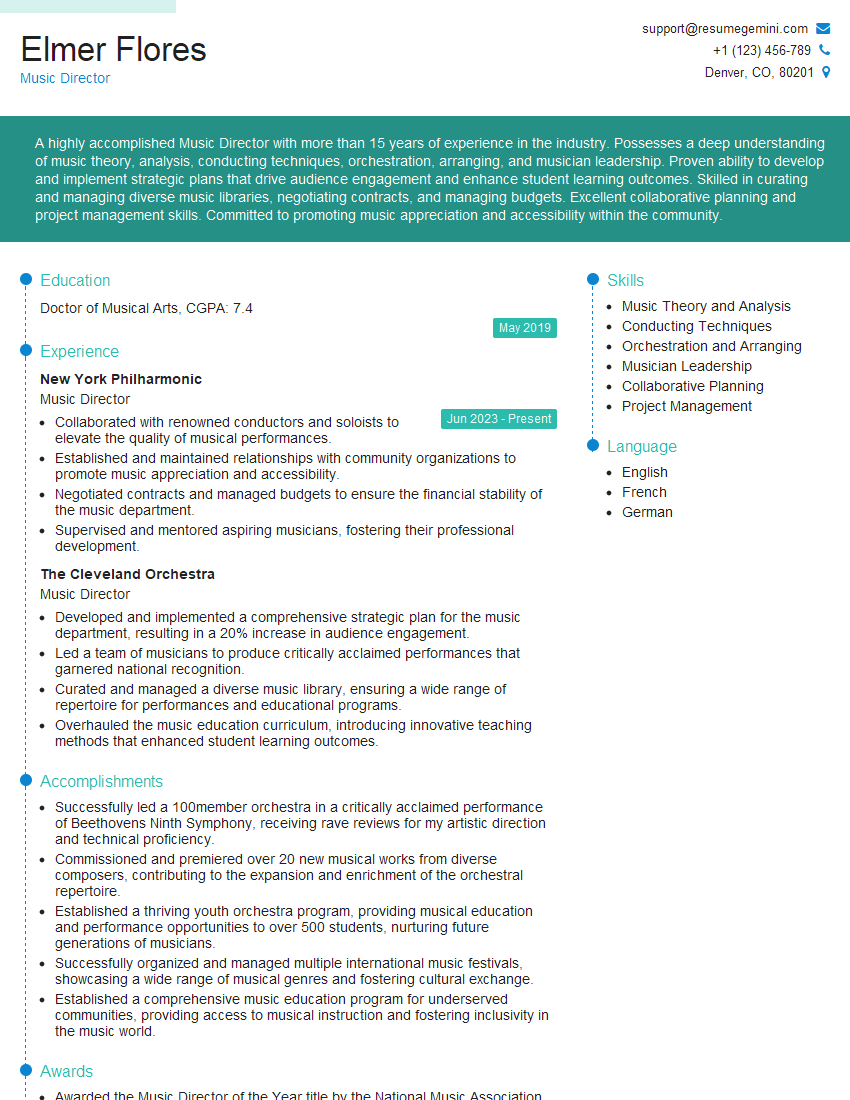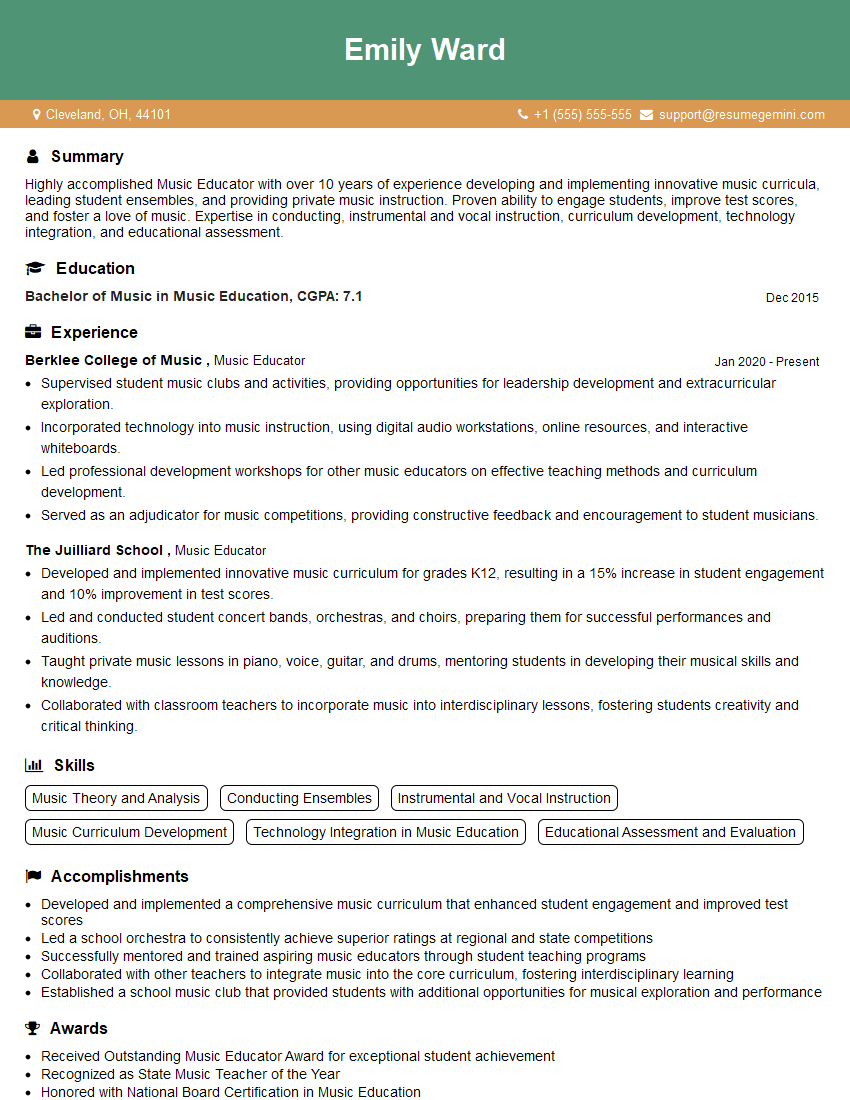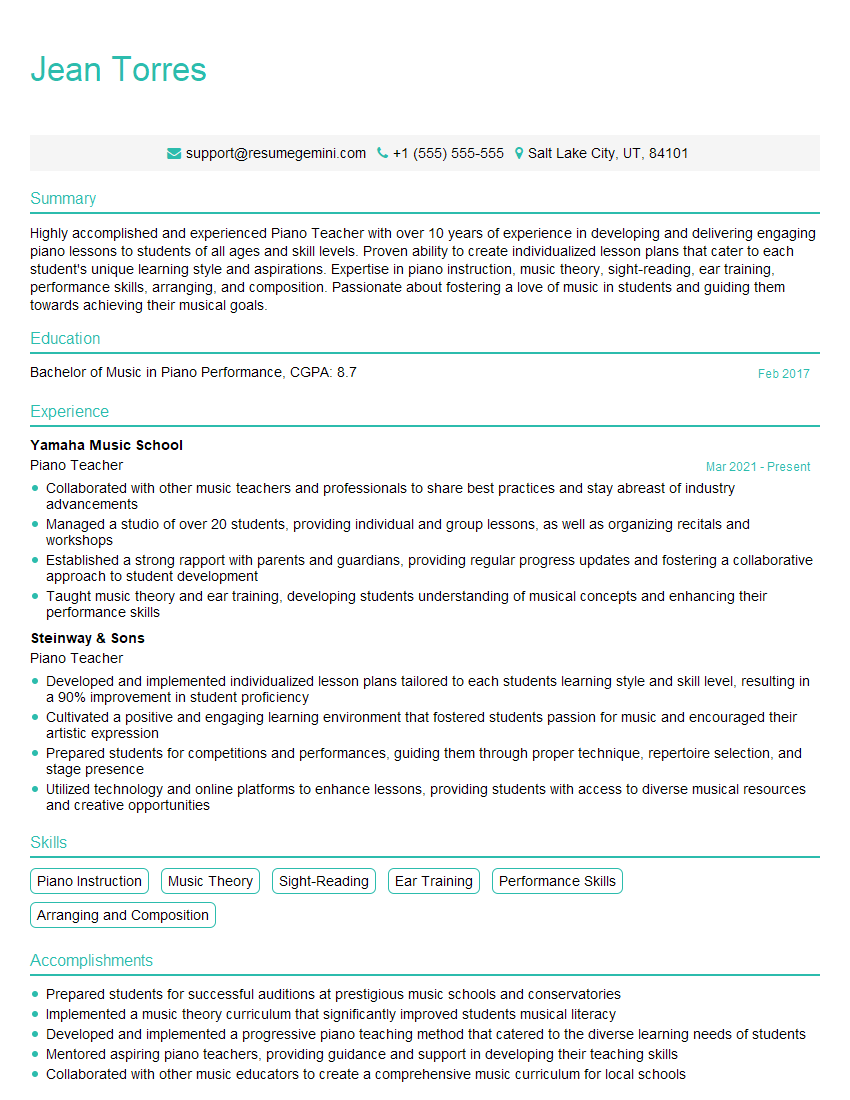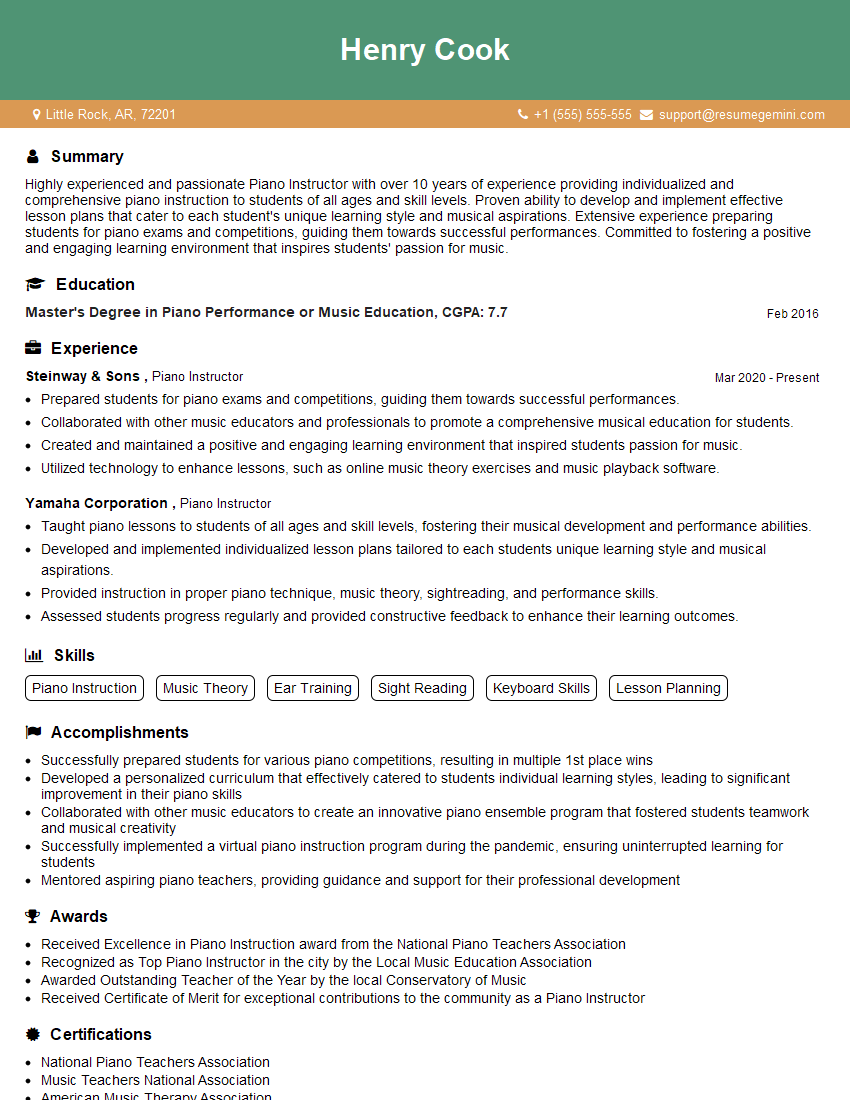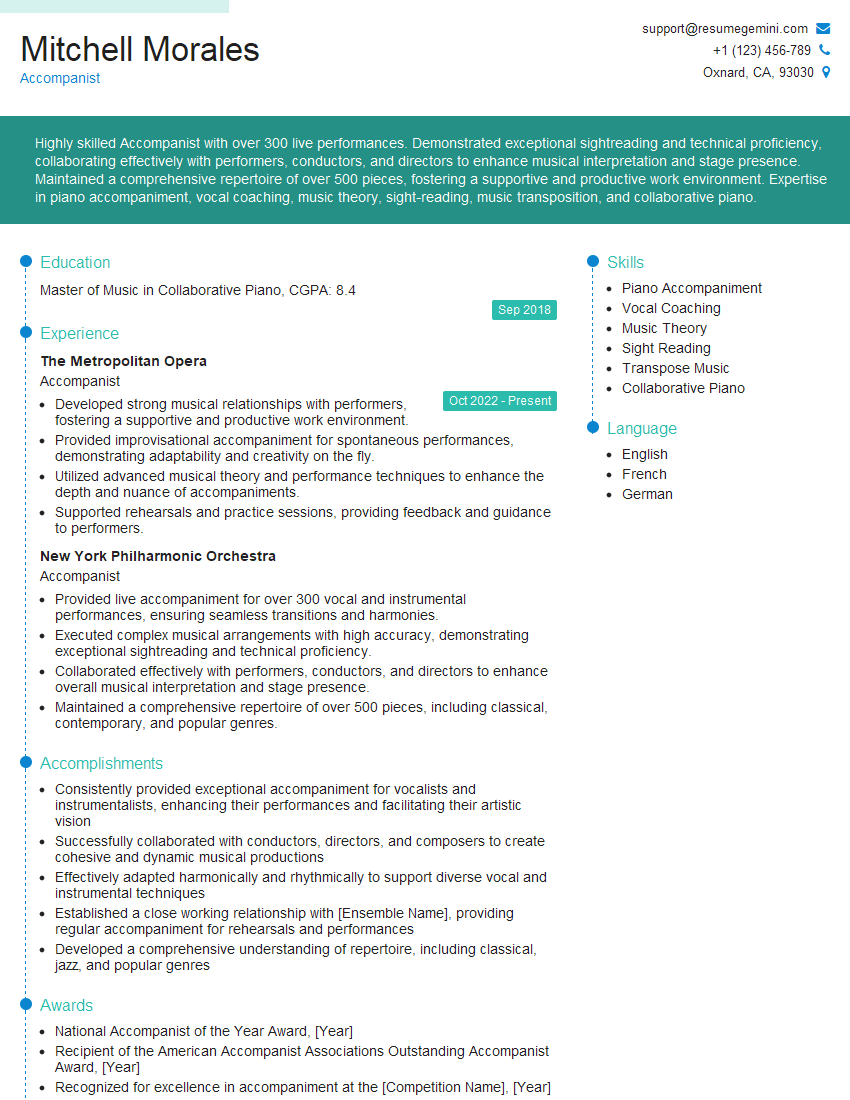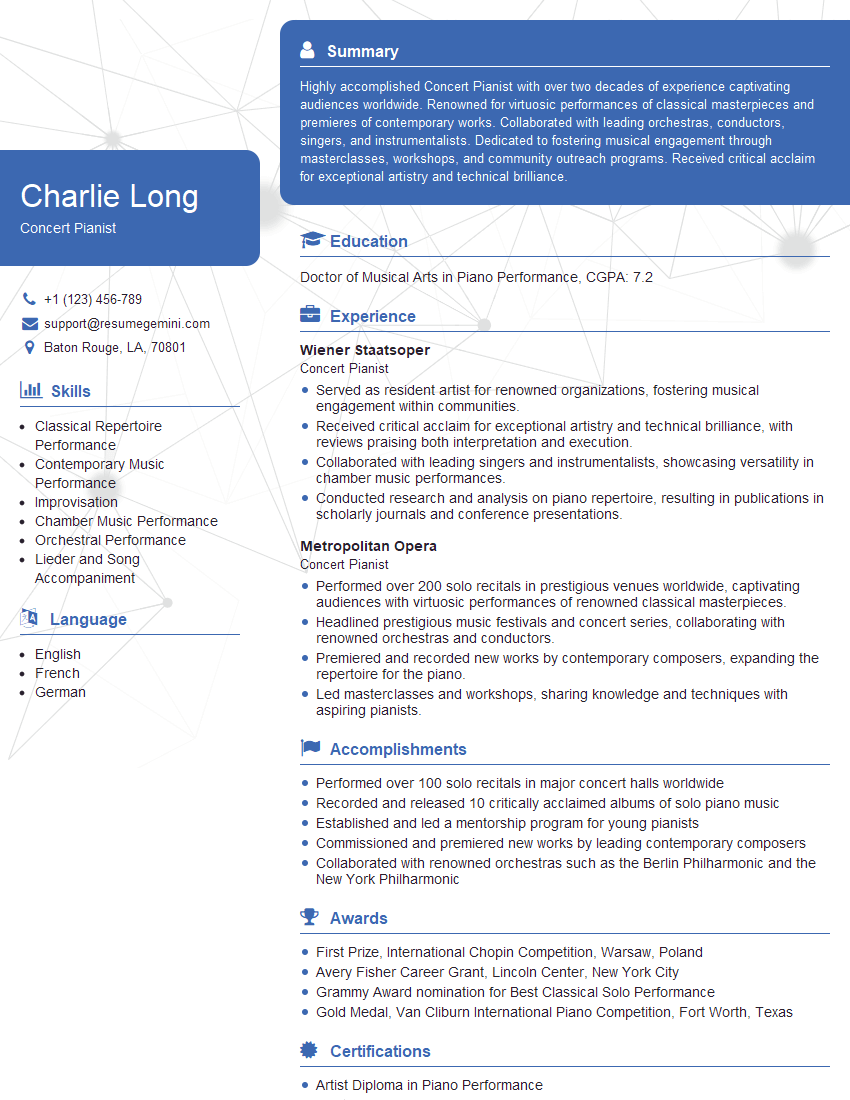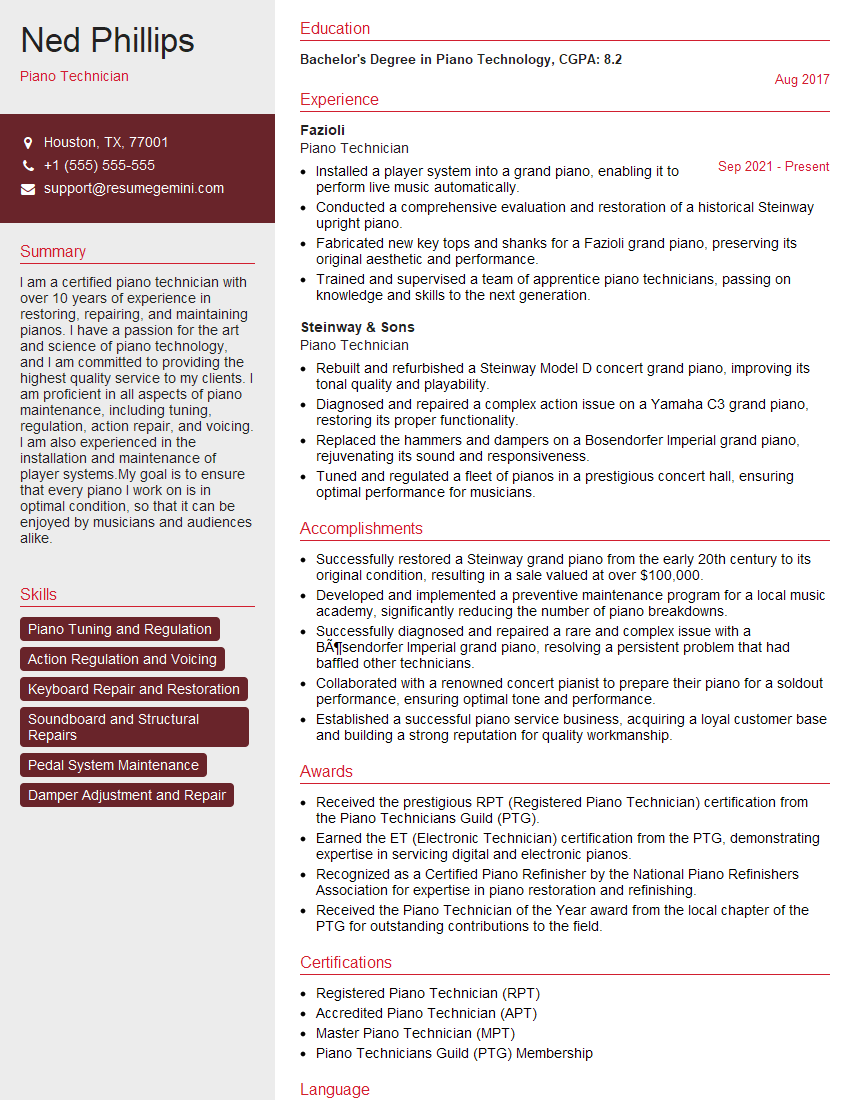Feeling uncertain about what to expect in your upcoming interview? We’ve got you covered! This blog highlights the most important Piano Playing interview questions and provides actionable advice to help you stand out as the ideal candidate. Let’s pave the way for your success.
Questions Asked in Piano Playing Interview
Q 1. Explain the difference between major and minor scales.
The difference between major and minor scales lies primarily in the arrangement of their intervals – the distances between the notes. A major scale is characterized by a bright, happy sound due to its specific intervallic structure: whole, whole, half, whole, whole, whole, half steps between consecutive notes. Think of the familiar ‘do-re-mi’ from ‘Sound of Music,’ that’s a major scale. A minor scale, conversely, has a more somber or reflective quality. There are three main types of minor scales – natural, harmonic, and melodic – each with slight variations in their intervallic structure, but they generally feature a minor third interval from the tonic (the starting note), giving them that characteristic ‘minor’ sound. For example, a C major scale is C-D-E-F-G-A-B-C, while a C natural minor scale is C-D-Eb-F-G-Ab-Bb-C.
This difference in intervallic structure affects the overall mood and feeling of a piece of music. Major scales are typically used for joyful, celebratory pieces, while minor scales lend themselves to more melancholic, dramatic, or introspective music.
Q 2. Describe your experience with different musical periods (e.g., Baroque, Classical, Romantic).
My experience spans various musical periods, each demanding a unique approach. The Baroque period (roughly 1600-1750) necessitates a deep understanding of counterpoint and ornamentation, techniques I’ve honed through studying Bach’s works, particularly his Well-Tempered Clavier. The clarity and articulation required for Baroque music differ significantly from the more expressive, passionate style of the Romantic period (roughly 1780-1900). My studies of Chopin and Liszt have instilled a sensitivity to rubato (flexible tempo) and dynamic shading essential for Romantic interpretation. The Classical period (roughly 1730-1820), exemplified by Mozart and Haydn, demands elegance, balance, and structural clarity. I’ve explored this through extensive study of their sonatas and concerti, developing a keen understanding of formal structure and phrasing. Each period presents distinct challenges and rewards, shaping my musical understanding and versatility.
Q 3. How do you approach sight-reading unfamiliar music?
Sight-reading is a crucial skill, and my approach involves a multi-step process. First, I quickly scan the piece to grasp its overall structure – key signature, time signature, and general melodic direction. Then, I start reading phrase by phrase, focusing on rhythm and melodic contours before delving into finer details like articulation and dynamics. I practice ‘chunking’ the music into manageable sections, ensuring rhythmic accuracy and phrasing before moving on. It’s less about speed and more about careful analysis. I often vocalize the melody silently as I read to enhance my understanding and internalize the musical line. Regular practice with a variety of styles and levels of difficulty is key to improving sight-reading proficiency.
Q 4. What techniques do you use for developing finger dexterity?
Developing finger dexterity requires consistent, focused practice. I utilize a combination of techniques: Scales and arpeggios are fundamental, but I also incorporate exercises that focus on specific finger combinations and patterns. Hanon exercises, while often considered tedious, are incredibly effective for building finger independence and strength. I also work on pieces that specifically challenge my dexterity, gradually increasing the tempo as my skill improves. Furthermore, I incorporate exercises that emphasize legato (smooth, connected playing) and staccato (short, detached notes), ensuring versatility and control. Regular practice, patience, and consistent effort are key ingredients in this process.
Q 5. Describe your method for practicing scales and arpeggios.
My method for practicing scales and arpeggios involves methodical progression. I start by playing them slowly and accurately, focusing on evenness of tone and articulation. I then gradually increase the tempo, always prioritizing accuracy over speed. I practice them in various octaves and hand positions to improve coordination and flexibility. I don’t just play them in a monotonous fashion. I experiment with different dynamics, articulations (legato, staccato, etc.), and rhythms to make the practice more engaging and to develop more nuanced control. The goal is not just technical proficiency but also musical expressiveness, even within the seemingly simple framework of scales and arpeggios.
Q 6. How do you handle performance anxiety?
Performance anxiety is a common challenge for musicians. My approach involves a combination of mental and physical preparation. Thorough practice is paramount; knowing the music inside and out reduces anxiety. I also incorporate relaxation techniques such as deep breathing and visualization. Mentally rehearsing the performance, imagining a successful outcome, helps build confidence. Furthermore, I focus on controlling my physical responses to anxiety – maintaining a steady posture and controlled breathing. Finally, performing in front of smaller, more supportive audiences gradually builds confidence for larger performances. The key is to recognize anxiety as a natural response and develop effective coping mechanisms.
Q 7. Explain your understanding of music theory, including harmony and counterpoint.
My understanding of music theory is extensive and forms the bedrock of my piano playing. Harmony is the foundation of how chords and progressions create musical structure and emotion. I understand the function of different chords within a key, the relationships between chords, and how to create interesting and effective harmonic progressions. Counterpoint, the art of combining independent melodic lines, is critical for understanding the structure of Baroque music and beyond. I can analyze contrapuntal textures, recognizing the interplay of voices and identifying techniques such as imitation, inversion, and canon. This knowledge allows me to analyze, interpret, and even compose music with a strong theoretical understanding.
For example, understanding harmonic function allows me to anticipate chord changes and create a cohesive musical narrative. Knowing counterpoint principles helps me decipher complex textures and appreciate the craftsmanship of composers like Bach. Music theory is not just theoretical knowledge; it’s a practical tool that enhances my musical expression and interpretation.
Q 8. What is your approach to teaching different age groups?
My approach to teaching piano varies significantly depending on the age group. With younger children (ages 5-8), the focus is on making learning fun and engaging. I use games, colorful visuals, and simplified arrangements to foster a love for music before introducing technical complexities. For example, I might use flashcards with musical notes to learn note recognition, or incorporate rhythm games with body percussion. With teenagers and adults, the approach becomes more structured, focusing on specific musical goals, be it mastering a particular technique, preparing for an exam, or developing performance skills. I tailor the curriculum to their individual needs and preferences, adjusting the pace and complexity accordingly. For instance, a teenager aiming for a performance might focus on repertoire selection and stage presence, while an adult learner might concentrate on developing a solid foundation in music theory and technique.
Q 9. How would you adapt your teaching style to accommodate various learning styles?
Accommodating diverse learning styles is crucial for effective teaching. I utilize a multi-sensory approach, catering to visual, auditory, and kinesthetic learners. Visual learners benefit from charts, diagrams, and sheet music, whereas auditory learners thrive on listening and repetition. Kinesthetic learners, who learn best through physical activity, engage more effectively with activities like playing scales and arpeggios. For example, when teaching a complex passage, I might demonstrate it visually on the keyboard, explain the fingering audibly, and then guide the student through the physical process of playing it. Regular assessment and feedback are key to adjusting my teaching style in response to the student’s progress and learning preferences.
Q 10. Describe your experience with accompanying singers or instrumentalists.
I have extensive experience accompanying singers and instrumentalists. This involves a deep understanding of musical phrasing, dynamics, and the ability to listen intently and respond sensitively to the performer. A successful accompaniment is a collaborative effort, requiring mutual respect, clear communication, and a shared musical vision. I’ve accompanied various vocalists, from soloists in recitals to choirs in large-scale performances, and instrumentalists ranging from string players to wind ensembles. In each instance, I meticulously study the score beforehand, paying close attention to the nuances of the melody and harmony. During rehearsals, open communication is vital to ensure a cohesive performance. I focus on adapting my playing to support the soloist or ensemble without overshadowing them, providing a solid harmonic foundation and enhancing the overall musical experience.
Q 11. What software or technology do you use to enhance your piano playing or teaching?
Technology significantly enhances both my piano playing and teaching. I use notation software like Sibelius and Finale for creating and editing scores, generating practice exercises, and sharing materials with students. For virtual teaching, I use platforms like Zoom, offering screen sharing to display musical scores and real-time feedback. Apps like Tenuto and Musictheory.net offer interactive exercises that engage students. Moreover, I utilize recording software to analyze my own performances, identify areas for improvement, and provide students with recordings of their practice sessions for self-assessment. This allows for a more detailed and objective evaluation of their progress.
Q 12. How do you maintain your piano and ensure optimal playing conditions?
Maintaining my piano is essential for optimal playing conditions. Regular tuning by a qualified technician is crucial, typically twice a year. I also keep the piano’s keys clean using a specialized cleaning solution to avoid dust accumulation and ensure smooth operation. Maintaining the humidity level in the room is important to prevent damage from excessive dryness or moisture. I use a hygrometer to monitor the humidity and employ humidifiers or dehumidifiers as needed. Regularly dusting and polishing the exterior preserves the piano’s aesthetic appeal and protects its finish. Preventing damage from extreme temperatures and direct sunlight is crucial. Proactive maintenance ensures the piano remains in peak condition, guaranteeing a consistently enjoyable and rewarding playing experience.
Q 13. What are your preferred methods for memorizing music?
My preferred methods for memorizing music involve a multi-faceted approach. I start by understanding the overall structure and form of the piece, identifying sections and recurring motifs. I then practice in small, manageable sections, gradually increasing the length as each section is mastered. I incorporate rhythmic and melodic analysis, internalizing the piece through repeated playing and visualization. I often sing or hum the melody while playing, strengthening the auditory memory. Breaking down complex passages into smaller, more digestible parts is key. I also incorporate mental rehearsal, picturing myself playing the piece, which helps to solidify the muscle memory and improve performance under pressure. Finally, regular practice sessions at different times and in different settings help consolidate memory.
Q 14. Describe your experience performing in different venues (e.g., concert halls, churches, studios).
I’ve performed in a variety of venues, each presenting unique challenges and rewards. Concert halls offer a grand setting with excellent acoustics but demand a precise and polished performance to fill the space. The acoustics require a different approach to dynamics and tone production. Churches often possess a unique reverberant quality requiring careful consideration of balance and projection. Smaller studio settings allow for a more intimate performance, fostering a close connection with the audience, but demand precision in expression. Each environment necessitates adapting one’s performance style and technique. I thrive on the unique characteristics of each venue, learning to harness the acoustic qualities to enhance the musical expression and connect with the audience on a deeper level.
Q 15. How do you interpret musical notation and expression markings?
Interpreting musical notation and expression markings is the key to bringing a piece of music to life. It’s not just about reading the notes; it’s about understanding the composer’s intentions and translating them into a performance.
Firstly, I meticulously analyze the rhythm and melody, ensuring accurate note values and articulation. For instance, a crescendo (gradually increasing volume) requires a careful increase in intensity, not just a sudden jump. Conversely, a decrescendo (gradually decreasing volume) demands a smooth tapering off of sound.
Secondly, I pay close attention to dynamics, tempo markings, and articulation symbols. A pianissimo (very soft) passage requires a delicate touch, while a fortissimo (very loud) passage requires a powerful and resonant sound. Similarly, legato (smooth and connected) phrasing necessitates a smooth connection between notes, unlike staccato (short and detached) which needs crisp, individual notes.
Finally, I consider the overall structure and form of the piece. Understanding phrases, sections, and the composer’s emotional intent allows me to shape the performance, conveying the music’s narrative effectively. For example, a dramatic climax demands a build-up in intensity, both technically and emotionally, while a peaceful interlude necessitates a sense of calm and tranquility.
Career Expert Tips:
- Ace those interviews! Prepare effectively by reviewing the Top 50 Most Common Interview Questions on ResumeGemini.
- Navigate your job search with confidence! Explore a wide range of Career Tips on ResumeGemini. Learn about common challenges and recommendations to overcome them.
- Craft the perfect resume! Master the Art of Resume Writing with ResumeGemini’s guide. Showcase your unique qualifications and achievements effectively.
- Don’t miss out on holiday savings! Build your dream resume with ResumeGemini’s ATS optimized templates.
Q 16. What is your approach to improvising?
Improvisation is a spontaneous creation of music, building on existing harmonic and melodic foundations. My approach is rooted in a strong understanding of music theory – scales, chords, and harmonic progressions. I start by listening to the harmonic context, identifying the key and chord changes. This serves as a framework for my improvisation.
Next, I use melodic motifs, rhythmic patterns, and stylistic elements inspired by the piece or genre I’m improvising in. For example, if improvising in a blues style, I would incorporate characteristic blue notes and rhythmic phrasing. I might also draw inspiration from specific composers or musicians, adapting their stylistic elements to my own creative expression.
Crucially, improvisation is a process of listening and reacting. I constantly monitor my improvisational phrases, adapting them to the harmonic and rhythmic flow, making sure the improvisation remains coherent and engaging. It’s a dynamic interplay between pre-conceived ideas and spontaneous creativity, a conversation between my musical intuition and the established musical framework.
Q 17. Explain your familiarity with different musical styles and genres.
My familiarity with musical styles and genres spans a wide range, from classical and baroque periods to contemporary jazz, pop, and even world music. I have extensively studied composers like Bach, Beethoven, and Chopin, understanding their distinct stylistic features and compositional techniques. This includes intricate counterpoint in Bach’s works, the dramatic intensity of Beethoven’s symphonies, and the lyrical beauty of Chopin’s nocturnes.
Beyond classical music, I possess a deep understanding of jazz harmony, improvisation techniques, and various jazz styles, from bebop to cool jazz and beyond. I’m equally comfortable playing popular music, having worked with various artists in different pop styles. My experience with world music exposes me to diverse rhythmic patterns, melodic structures, and instrumentation from cultures around the globe.
This broad understanding allows me to approach music with flexibility and versatility, adapting my technique and stylistic choices to suit the specific demands of each genre. The common thread is a commitment to technical excellence and musical expression, regardless of the style.
Q 18. How do you address student challenges or mistakes effectively?
Addressing student challenges involves a patient and multifaceted approach. I start by identifying the root cause of the mistake. Is it a technical issue (fingering, posture), a musical misunderstanding (rhythm, harmony), or a matter of confidence? Once identified, I develop a tailored strategy.
For technical problems, I provide detailed explanations and demonstrate proper technique, often using slow practice techniques and focused exercises. For musical misunderstandings, I break down complex musical concepts into smaller, manageable parts, using analogies and real-world examples to aid understanding. For confidence issues, I foster a supportive and encouraging environment, celebrating small successes and focusing on progress rather than perfection.
I use a combination of methods including visual aids, listening examples, and interactive exercises to reinforce learning. I also encourage self-reflection and active listening. Regular assessments allow me to track progress and adapt my teaching methods to best meet each student’s individual needs. Ultimately, learning should be engaging and empowering.
Q 19. Describe your experience working with different types of pianos (e.g., acoustic, digital).
My experience encompasses both acoustic and digital pianos, each with its unique characteristics. Acoustic pianos offer a rich, complex tone that’s influenced by the instrument’s construction and the environment. The touch sensitivity is nuanced, requiring a precise and responsive technique. I appreciate the organic feel and the subtle variations in sound that an acoustic piano provides.
Digital pianos, on the other hand, offer convenience and versatility. They often have features like adjustable voicing, metronomes, and recording capabilities. While the sound and touch sensitivity can vary greatly depending on the model, high-quality digital pianos provide a close approximation to the acoustic experience. I find these particularly useful for practice in diverse settings, where an acoustic piano might not be readily available.
My ability to adapt to both types of instruments ensures my teaching is flexible and effective, regardless of the instrument the student uses. Understanding the unique characteristics of each allows for appropriate instruction and technique development.
Q 20. How do you create engaging and effective lesson plans?
Creating engaging and effective lesson plans starts with understanding the student’s individual needs, goals, and learning style. I then develop a structured plan that balances technical exercises with musical exploration. The plan typically includes:
- Warm-up exercises: To prepare the hands and mind.
- Technical studies: Focusing on specific skills like scales, arpeggios, or chords.
- Repertoire pieces: Selected based on the student’s level and interests, promoting musicality and expression.
- Theory concepts: Integrated into the lesson to deepen understanding.
- Performance opportunities: Providing opportunities to apply learned skills and build confidence.
I aim for a balance of structured practice and creative exploration, incorporating elements of games, improvisation, and listening activities to keep students motivated and engaged. Regular feedback and adjustments ensure the plan remains relevant and effective throughout the learning journey.
Q 21. What is your philosophy of music education?
My philosophy of music education is centered on holistic development. It’s not just about acquiring technical skills; it’s about fostering a lifelong love of music. I believe in creating a supportive and nurturing learning environment that encourages self-expression, creativity, and discipline.
I emphasize the importance of understanding music theory alongside practical application. Technical skills are crucial, but understanding the ‘why’ behind musical choices elevates the playing experience. I encourage students to listen critically, develop their own musical voice, and understand the historical and cultural contexts of the music they play.
Ultimately, my aim is to empower students with the skills and confidence to explore the world of music, whether they choose to pursue it professionally or simply enjoy it as a lifelong hobby. Music is a powerful tool for personal growth, and I strive to make that evident in my teaching.
Q 22. Describe your experience with composing or arranging music.
My experience in composing and arranging music spans over fifteen years, encompassing diverse styles from classical to contemporary jazz. I began by transcribing my favorite pieces, a process that honed my understanding of musical structure and harmony. This evolved into creating my own compositions, initially simple piano pieces, and then more complex works incorporating other instruments. My arranging experience involves adapting existing pieces for different ensembles, such as scoring a solo piano piece for a string quartet. I often utilize notation software such as Sibelius or Finale to create professional-quality scores. For example, I recently arranged a Chopin nocturne for a piano trio, adapting the harmonic structure to accommodate the added instrumental voices while maintaining the emotional core of the original composition. Another project involved composing a custom piece for a student recital, tailoring the musical style and difficulty to suit their skill level.
Q 23. How do you use rhythmic and harmonic analysis to enhance your understanding of a piece?
Rhythmic and harmonic analysis are fundamental to my understanding and interpretation of a piece. Rhythmic analysis involves breaking down complex rhythms into simpler patterns, identifying rhythmic motives, and understanding their function within the larger structure. For instance, identifying syncopation or hemiola (a rhythmic interplay where a 3/4 meter feels superimposed over a 2/4 meter) significantly enhances my ability to create a convincing and nuanced performance. Harmonic analysis delves into the chord progressions and their relationships, identifying functional harmony (tonic, dominant, subdominant), and understanding the harmonic vocabulary of the composer. By understanding the harmonic progression, I can better anticipate harmonic shifts and nuances in phrasing and dynamics. For example, analyzing a piece in a minor key might reveal a series of augmented sixth chords creating a poignant emotional effect, guiding my interpretation towards a more expressive performance. A practical application of this analysis is reflected in my teaching; I frequently break down complex passages with my students to illuminate the underlying rhythmic and harmonic patterns, making them more accessible and understandable.
Q 24. How do you assess a student’s progress and tailor lessons accordingly?
Assessing a student’s progress involves a multifaceted approach. I regularly observe their technique, musicality, and overall understanding of the material. This includes evaluating their posture, hand position, finger dexterity, and ability to accurately interpret the score’s nuances. I use a combination of formal assessments (e.g., recitals, exams) and informal observations during lessons. For instance, I assess their progress on scales and arpeggios not just for technical proficiency but also for evenness of touch, clarity, and tone quality. I also consider their progress in understanding musical concepts like phrasing, dynamics, and articulation. Tailoring lessons is crucial, and this involves adapting the curriculum based on their strengths and weaknesses, learning styles, and individual goals. A student struggling with rhythm might require more focused exercises on rhythmic dictation and coordination, while another student excelling in technique might benefit from exploring more advanced repertoire or composing exercises.
Q 25. What are your strengths and weaknesses as a pianist?
My strengths as a pianist lie in my technical proficiency, particularly in my ability to execute complex passages with clarity and precision. I’m also adept at interpreting and conveying the emotional depth of a piece, ensuring musicality is paramount in my performances. My ability to effectively communicate musical ideas to students is another key strength. However, my weaknesses include occasionally over-analyzing pieces, sometimes at the expense of spontaneity and emotional expression. I’m also conscious of the need to improve my repertoire in contemporary music styles, focusing on expanding my comfort zone beyond my current specialisation in classical and Romantic periods.
Q 26. How do you stay current with the latest trends and developments in piano playing?
Staying current involves continuous learning. I regularly attend masterclasses and workshops, providing opportunities to learn from renowned pianists and educators. I engage with the contemporary piano literature, exploring works by both established and emerging composers. Additionally, I subscribe to relevant journals and online resources, keeping abreast of new pedagogical approaches and technological advancements in music education. I also actively seek feedback from colleagues and other musicians, fostering a continual process of self-reflection and improvement. For example, exploring the work of contemporary composers like Ludovico Einaudi has broadened my understanding of harmonic language and expressive possibilities, influencing my teaching and performance approaches.
Q 27. Describe your experience in collaborating with other musicians.
Collaboration with other musicians has been an invaluable part of my musical journey. I’ve performed in chamber ensembles, collaborating with string players, woodwind players, and singers. These experiences have enhanced my understanding of ensemble dynamics, balance, and musical communication. I’ve also worked with composers, performing premieres of new works and contributing to the creative process. For instance, participating in a string quartet project required me to navigate the complexities of ensemble playing, adjusting my own interpretation to complement that of my colleagues. These collaborative experiences have significantly enriched my musical development and broadened my perspectives.
Key Topics to Learn for Your Piano Playing Interview
- Musical Theory Fundamentals: Understanding scales, chords, key signatures, and rhythmic notation is crucial for demonstrating a solid foundation. Be prepared to discuss their practical application in various musical contexts.
- Performance Techniques: Articulation, dynamics, phrasing, and pedaling are essential aspects of musical expression. Prepare to discuss how you apply these techniques to achieve a desired musical effect, and be ready to explain your personal approach.
- Sight-Reading Proficiency: Demonstrate your ability to interpret and perform unfamiliar music accurately and musically. Practice with a variety of styles and complexities.
- Improvisation and Composition: Depending on the role, you may be asked about your improvisational skills or compositional experience. Prepare examples to showcase your creativity and musical understanding.
- Musical History and Styles: A broad understanding of different musical periods and styles will showcase your overall musical knowledge and context. Be prepared to discuss your favorite composers and their impact on your playing.
- Teaching Methodology (if applicable): If applying for a teaching position, be ready to discuss your teaching philosophy, methods, and experience working with students of varying skill levels.
- Problem-Solving & Adaptability: Discuss how you approach challenges in learning new pieces, overcoming technical difficulties, or adapting to different performance situations.
Next Steps
Mastering piano playing opens doors to diverse and rewarding careers, from performing and teaching to composing and music therapy. To maximize your job prospects, crafting an ATS-friendly resume is paramount. A well-structured resume helps your application stand out and ensures it’s effectively scanned by Applicant Tracking Systems. We strongly recommend using ResumeGemini to build a professional and impactful resume. ResumeGemini provides tailored resume examples for Piano Playing professionals, helping you present your skills and experience effectively to potential employers.
Explore more articles
Users Rating of Our Blogs
Share Your Experience
We value your feedback! Please rate our content and share your thoughts (optional).
What Readers Say About Our Blog
Hello,
We found issues with your domain’s email setup that may be sending your messages to spam or blocking them completely. InboxShield Mini shows you how to fix it in minutes — no tech skills required.
Scan your domain now for details: https://inboxshield-mini.com/
— Adam @ InboxShield Mini
Reply STOP to unsubscribe
Hi, are you owner of interviewgemini.com? What if I told you I could help you find extra time in your schedule, reconnect with leads you didn’t even realize you missed, and bring in more “I want to work with you” conversations, without increasing your ad spend or hiring a full-time employee?
All with a flexible, budget-friendly service that could easily pay for itself. Sounds good?
Would it be nice to jump on a quick 10-minute call so I can show you exactly how we make this work?
Best,
Hapei
Marketing Director
Hey, I know you’re the owner of interviewgemini.com. I’ll be quick.
Fundraising for your business is tough and time-consuming. We make it easier by guaranteeing two private investor meetings each month, for six months. No demos, no pitch events – just direct introductions to active investors matched to your startup.
If youR17;re raising, this could help you build real momentum. Want me to send more info?
Hi, I represent an SEO company that specialises in getting you AI citations and higher rankings on Google. I’d like to offer you a 100% free SEO audit for your website. Would you be interested?
Hi, I represent an SEO company that specialises in getting you AI citations and higher rankings on Google. I’d like to offer you a 100% free SEO audit for your website. Would you be interested?
good
